Have you ever been captivated by the sound of a guitar, dreaming of creating melodies yourself? Many people, from all walks of life, share this aspiration to learn how to play guitar. Whether you envision yourself performing on stage or simply enjoying music in your own home, starting your guitar journey is within reach. If you’re here, it means you’re ready to take that exciting first step!
Congratulations on deciding to learn guitar! This guide will walk you through the essential first steps towards playing like the guitarists you admire. We’ll explore everything from choosing your first instrument to strumming your initial chords. Throughout this article, you’ll find links to further resources on our blog to deepen your knowledge and accelerate your learning process.
1. Acoustic vs. Electric Guitar: Which is Right for You?
The first big decision when learning how to play guitar is choosing between an acoustic and an electric guitar. Both are fantastic instruments, but they offer different experiences, especially for beginners. We have detailed guides to help you choose the right acoustic guitar and electric guitar on our blog.
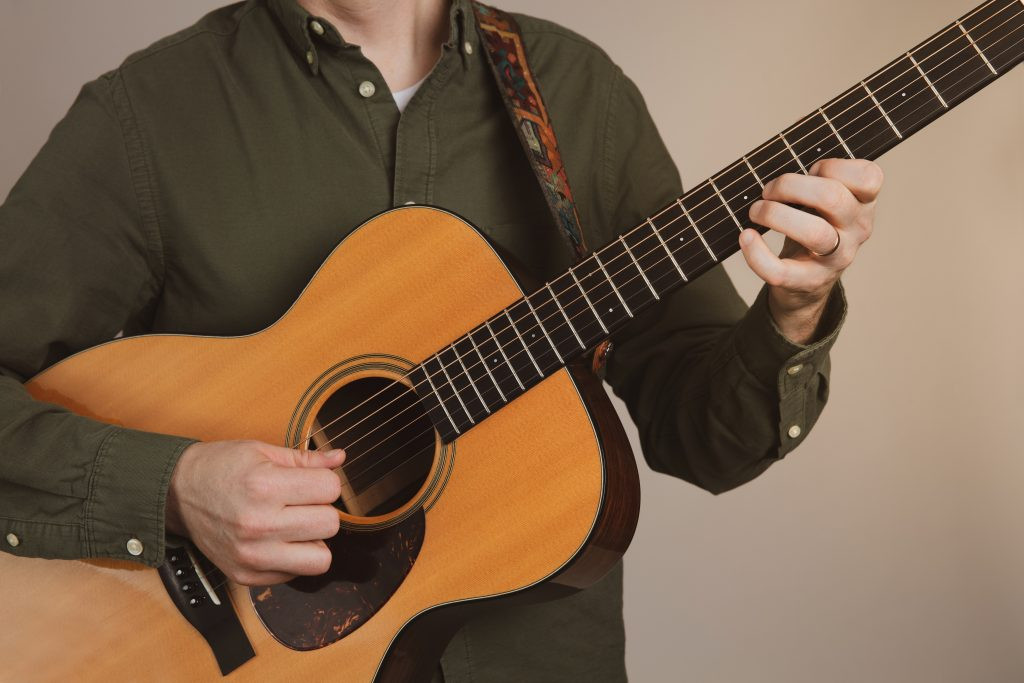 Two guitars, an acoustic guitar on the left and an electric guitar on the right, leaning against a wall
Two guitars, an acoustic guitar on the left and an electric guitar on the right, leaning against a wall
Acoustic Guitars: A Great Starting Point
Acoustic guitars are often recommended for beginners learning how to play guitar. Especially guitars with nylon strings are known for being gentler on new fingertips. They are generally more affordable than electric guitars, making them an accessible entry point. However, if you’re serious about learning, investing in a mid-range acoustic guitar is a wise choice. A better quality instrument will not only sound better but will also be more enjoyable to play as you progress beyond the beginner level. Look for features like solid top woods for improved sound and comfortable neck profiles for easier playing.
 A person holding a nylon string acoustic guitar in a relaxed setting
A person holding a nylon string acoustic guitar in a relaxed setting
Electric Guitars: Versatility and Rock and Roll
Electric guitars typically come with a higher price tag initially, but they offer a wider range of sounds and styles. If you’re drawn to genres like rock, blues, or metal, an electric guitar might be the perfect starting point for you to learn how to play guitar. While you’ll also need an amplifier and potentially accessories like distortion pedals to achieve those iconic rock tones, the versatility of an electric guitar can be incredibly inspiring. Electric guitars often have thinner necks and lower action (string height), which some beginners find easier to play than acoustic guitars with steel strings.
2. Getting to Know Your Instrument: Guitar Anatomy
To effectively learn how to play guitar, understanding the different parts of your instrument is essential. Each component plays a role in creating sound and enabling you to play. Familiarizing yourself with guitar parts will also make it easier to communicate with other musicians and understand guitar lessons. Key parts include:
- Body: The main resonant part of the guitar that amplifies the sound.
- Fretboard: The wooden surface on the neck where you press down the strings to change pitch.
- Frets: Metal strips embedded in the fretboard that divide the neck into semitones.
- Neck: The long piece of wood that connects the headstock to the body and supports the fretboard.
- Headstock: Located at the top of the neck, it holds the tuning pegs.
- Strings: Usually six in number, they vibrate to produce sound.
- Tuning Pegs (Tuners): Used to adjust the tension of the strings and tune the guitar.
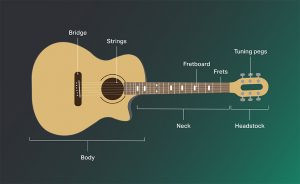 Diagram showing the different parts of an acoustic guitar, including headstock, tuning pegs, neck, fretboard, body, and soundhole
Diagram showing the different parts of an acoustic guitar, including headstock, tuning pegs, neck, fretboard, body, and soundhole
Depending on whether you have an acoustic or electric guitar, you’ll notice some specific features. Acoustic guitars typically have a soundhole in the body to project sound, while electric guitars may have pickups, volume and tone knobs, and input jacks for connecting to amplifiers.
3. Finding the Right Posture: How to Hold a Guitar
The way you hold your guitar is crucial for comfort, preventing injury, and allowing your hands to move freely. Whether you choose an acoustic or electric guitar, proper posture is key to learning how to play guitar effectively. Your personal preference and body type will also play a role in finding what feels most natural.
For acoustic guitar, sitting is the most common position. You can rest the guitar on your lap, usually with the curve of the body resting on your right or left leg (depending on whether you are right or left-handed). Using a guitar strap even while sitting can sometimes improve posture and comfort.
Electric guitarists often play while sitting, especially when practicing. However, playing standing up is common, particularly in performance settings. A guitar strap is essential for playing an electric guitar standing up.
 Person sitting and holding an acoustic guitar in a relaxed and correct posture
Person sitting and holding an acoustic guitar in a relaxed and correct posture
Orient your guitar so that the thickest string (the low E string) is at the top when you look down at it. The hand that presses down on the strings on the neck is called the “fretting hand” (usually the left hand for right-handed players). The other hand, used for strumming or picking, is known as the “picking hand” or “strumming hand” (usually the right hand for right-handed players).
If you’re left-handed, you have options. You can learn to play a standard right-handed guitar, play a flipped right-handed guitar (strings reversed), or use a dedicated left-handed guitar. Experiment to find what feels most comfortable and natural for you.
4. Navigating the Fretboard and Strings
Understanding the fretboard and strings is fundamental to learning how to play guitar. The six strings are named, from thickest to thinnest (lowest pitch to highest): E, A, D, G, B, and E. Remember “Every Adult Dog Growls Bites Eats” as a mnemonic. The thickest string, closest to your head when holding the guitar, is the low E string.
Pressing strings down onto the fretboard, known as “fretting,” shortens the vibrating length of the string, thus changing the pitch. Expect your fingertips to feel sore initially. This is normal! With consistent practice, calluses will develop, and it will become much more comfortable. Nylon strings are softer on the fingers than steel strings, which is another reason why nylon-string acoustic guitars are often recommended for beginners.
To produce a clear sound, press the string down just behind the fret (closer to the headstock), not directly on top of the fret. Apply enough pressure to ensure the string rings out clearly without buzzing.
5. Tuning Your Guitar: Getting in Pitch
Playing a guitar that’s out of tune can be discouraging and hinder your progress in learning how to play guitar. Accurate tuning is essential for a pleasant sound and for developing your ear. For beginners, standard tuning (EADGBE) is the starting point, and you don’t need to worry about alternate guitar tunings just yet.
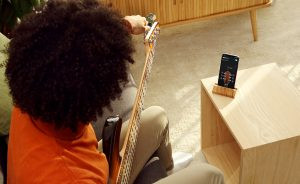 Close up of guitar headstock with tuning pegs being adjusted
Close up of guitar headstock with tuning pegs being adjusted
The easiest way to tune your guitar is by using an electronic tuner. These devices are inexpensive and readily available. Alternatively, smartphone apps like GuitarTuna offer free and accurate tuning capabilities. Guitar tuner apps are incredibly convenient as you always have them with you on your phone. Learning to tune by ear is a valuable skill that develops over time, but using a tuner app is perfect for beginners.
6. Mastering Basic Guitar Chords: Your First Building Blocks
Before attempting complex solos, start with the fundamentals: guitar chords. Understanding guitar chord charts is very helpful as they visually represent how to position your fingers to form different chords. Begin with open chords, sometimes referred to as “cowboy chords,” as they are typically easier to play for beginners. These are divided into major and minor chords.
Our extensive guitar chord library is a fantastic resource if you ever need a quick reference for how to play a particular chord.
Major Chords: Bright and Happy Sounds
When learning how to play guitar, start slowly and build a solid foundation. Learning just a few basic major chords is enough to play countless songs! Excellent major chords to begin with are A, D, C, and E. Here’s an example of a guitar chord chart for the E major chord: (Insert E major chord chart image if available).
Minor Chords: Melancholy and Emotional Depth
Great minor chords for beginner guitarists include A minor (Am) and E minor (Em). Minor chords are denoted with a lowercase “m.” Minor chords provide a different emotional flavor compared to major chords. Here’s how to play the E minor chord:
 Guitar chord diagram showing how to play the E minor chord
Guitar chord diagram showing how to play the E minor chord
You can distinguish major and minor chords by their sound. Major chords generally sound bright and happy, while minor chords tend to sound darker and more melancholic.
7. Strumming Guitar Chords: Creating Rhythm
To play music with guitar chords, you need to strum across multiple strings simultaneously. For some chords, like D and C, you only strum certain strings and avoid others. This is why some chords are initially easier to play cleanly than others. It’s crucial to avoid accidentally muting strings with your strumming hand or fretting hand fingers.
Once you can strum basic open chords cleanly, you can start experimenting with downstrokes and upstrokes, and then move on to more intricate strumming patterns and chord progressions. Exploring different chord types, including barre chords, will expand your musical vocabulary, though barre chords typically come later in your learning journey.
8. Reading Guitar Tablature (Tabs): Playing Melodies and Riffs
When you want to play melodies, riffs, and solos beyond just strumming chords, guitar tablature, or “tabs,” becomes invaluable. Guitar tabs are a simplified way to read music notation specifically for guitar. They visualize the guitar fretboard, making it intuitive to learn songs. Horizontal lines represent the guitar strings, and numbers on the lines indicate which fret to play on that string. “0” represents an open string, and “X” indicates a muted string. The bottom line is the low E string, and the top line is the high E string.
Tabs are versatile and used by guitarists of all levels. They can represent chords, single notes, and techniques like slides, bends, hammer-ons, pull-offs, and more. Learning to read guitar tabs opens up a vast world of musical possibilities and allows you to learn countless songs and guitar parts.
9. Picking and Using a Guitar Pick (Plectrum)
Playing individual notes can be done with your fingers, a technique called fingerpicking. However, using a guitar pick (also called a plectrum) is often preferred, especially for electric guitar and for achieving a brighter, more articulate sound on acoustic guitar. Picks are also essential for faster strumming and lead guitar playing. Guitar picks come in various thicknesses and materials, each influencing the tone and playing feel. Thickness is a crucial factor; thinner picks are more flexible, while thicker picks offer more control and a bolder sound.
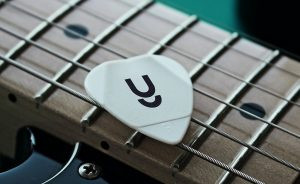 A hand holding a Yousician branded guitar pick
A hand holding a Yousician branded guitar pick
To use a pick for single-note picking, hold it between your thumb and index finger, with a small portion of the pick extending out. Keep your other fingers relaxed. Avoid gripping the pick too tightly. Practice picking individual strings slowly at first, focusing on accuracy. Gradually increase your speed and practice both downstrokes and upstrokes. Don’t worry about mistakes initially; developing pick control takes time and practice.
10. Exploring Guitar Scales: Building Blocks for Solos
Guitar scales and music theory might seem daunting at first, but scales are fundamental tools for understanding the fretboard and creating melodies and solos. Scales are ordered sequences of notes within an octave. Learning scales helps you understand the relationships between notes and provides patterns to navigate the fretboard. Scales are invaluable for improvisation and songwriting. Like chords, scales come in major and minor variations, each with a distinct sound.
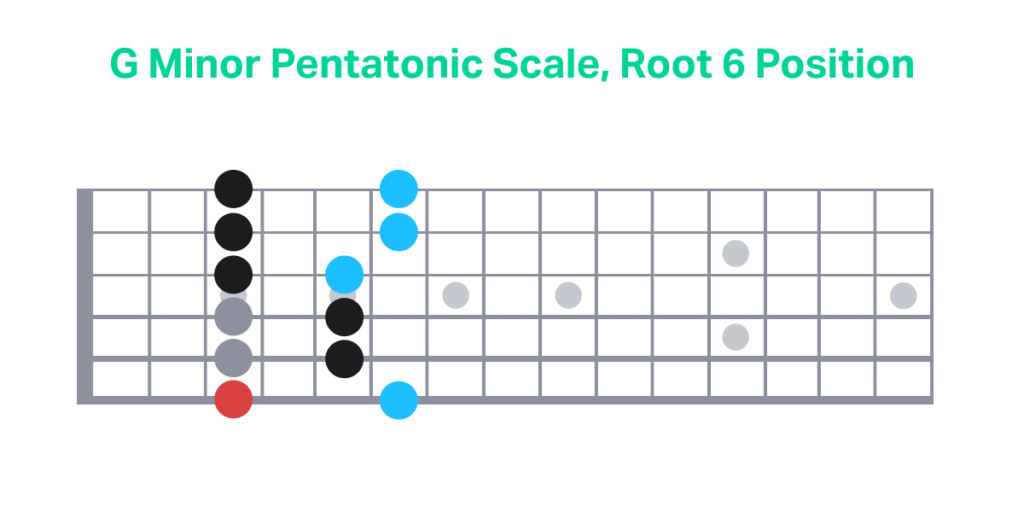 Guitar fretboard diagram showing the G Minor Pentatonic Scale in Root 6 Position
Guitar fretboard diagram showing the G Minor Pentatonic Scale in Root 6 Position
Yousician offers interactive exercises to help you master different guitar scales. Practicing scales by playing them up and down the fretboard is an effective way to memorize them and build finger dexterity. As you become comfortable with scales, gradually increase your speed to enhance your technique.
11. Playing Your Favorite Songs: Putting it All Together
Now for the most rewarding part: playing your favorite songs on guitar! Forget about cumbersome sheet music books; the internet provides access to guitar tabs and chords for almost any song imaginable. Simply search online for the song title plus “tab” or “chords,” and you’ll likely find transcriptions created by other guitarists.
Interactive music learning apps like Yousician take song learning to the next level. Explore Yousician’s extensive library of popular songs spanning diverse artists, bands, and genres. You might just find your favorite song ready for you to learn and play!
12. The Key to Progress: Consistent Practice
Once you grasp basic chords, tuning, fretboard navigation, and reading tabs, the most crucial element is consistent practice. Make guitar practice a regular part of your routine, even if it’s just for short sessions each day. While your fingertips might feel tender initially, your hands will adapt to playing guitar as you build finger strength and muscle memory.
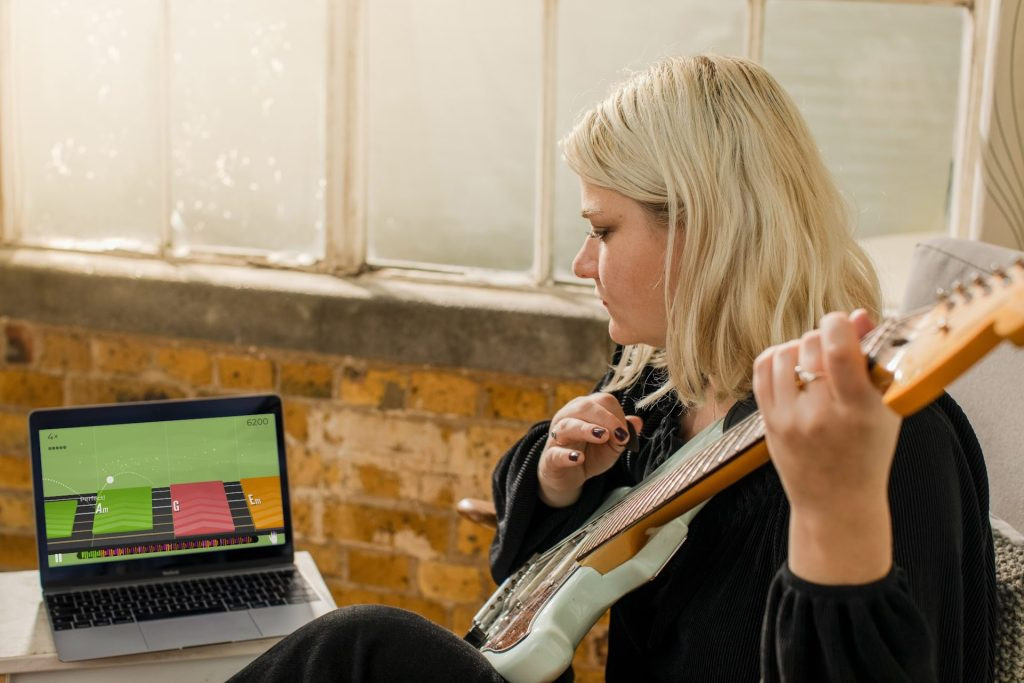 A woman practicing guitar with a laptop showing Yousician app in a comfortable home setting
A woman practicing guitar with a laptop showing Yousician app in a comfortable home setting
Learn Guitar Basics with Yousician!
While dedicated practice is essential, remember that learning how to play guitar should be enjoyable! If you make it too serious and lose the fun, your motivation might dwindle. This is where Yousician can be a game-changer.
Yousician acts as your personalized guitar teacher, guiding you through interactive lessons at your own pace. You’ll progressively learn new skills while having fun. Yousician’s song library provides a vast selection of songs to play along with. The app provides real-time feedback, making practice sessions engaging and motivating, and helping you track your progress and improve your guitar skills effectively.
Download Yousician on your computer or mobile device and embark on your musical journey today!
Frequently Asked Questions for Beginner Guitar Players
Starting to learn how to play guitar often comes with many questions. Here are some encouraging answers for those beginning their guitar journey:
How Long Does it Take to Learn to Play Guitar?
The learning curve for guitar varies significantly. Factors like practice frequency, practice quality, and individual learning styles all play a role. Prior musical experience with other instruments, such as piano, can also be beneficial.
Regardless of these factors, consistent practice is the key to progress. With regular practice, you can move beyond the beginner stage within a few months and reach an intermediate level in one to three years. Guitar mastery is a lifelong pursuit requiring years of dedicated practice – but think of this as a positive aspect, as there will always be new musical horizons to explore!
How Often Should I Practice Guitar?
As a beginner, aim for 15-30 minutes of focused practice most days of the week. If you feel inspired and are enjoying the process, by all means, practice longer! However, don’t be discouraged if you miss a practice day occasionally. Consistency is more important than marathon practice sessions. Even short, regular practice is more effective than infrequent long sessions. To maximize your practice, minimize distractions and concentrate on your playing – while keeping it fun!
Do I Need to Learn Music Theory to Play Guitar?
While you can learn to play guitar without in-depth music theory knowledge, understanding some music theory concepts will definitely enhance your progress and deepen your appreciation for music. Basic music theory can help you learn songs faster and understand musical structures better. However, if your primary goal is simply to have fun and play your favorite songs, don’t let music theory be a barrier to starting! You can always explore music theory later as your interest grows.
How Can I Learn Guitar at Home Effectively?
Learning guitar from scratch can feel overwhelming without guidance. Having support and direction is always beneficial. Fortunately, learning guitar at home is easier than ever before, even without a traditional in-person teacher. Online guitar lessons, video tutorials, and interactive music learning apps provide structured learning paths and make it convenient to learn at your own pace from home.
Can I Teach Myself Guitar?
Becoming a self-taught guitarist is absolutely achievable, and many legendary guitarists, like Jimi Hendrix and Eric Clapton, were self-taught! Learning guitar independently is more accessible than ever, thanks to the wealth of online resources and music learning technology. With apps and readily available online resources, even on your smartphone, you can learn at home and become a proficient guitar player through self-study and dedication.
Ready to start playing?
Play the songs you love with Yousician. Try Premium+ free for 7 days. Sign up and start learning now.
Start your free trial
